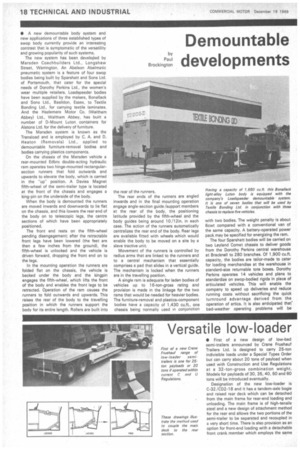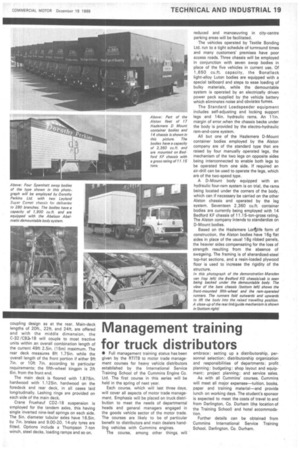Demountable developments
Page 20

Page 21

If you've noticed an error in this article please click here to report it so we can fix it.
by Pa ii I Brockington
• A new demountable body system and new applications of three established types of swop body currently provide an interesting contrast that is symptomatic of the versatility and growing popularity of such systems.
The new system has been develoPed by Marsden Coachbuilders Ltd., Longshaw Street, Warrington. An Abelson Abelmatic pneumatic system is a feature of four swop bodies being built by Sparshatt and Sons Ltd. of Portsmouth, that cater for the special needs of Dorothy Perkins Ltd., the women's wear multiple retailers. Loadspeeder bodies have been supplied by the makers, BonaIlack and Sons Ltd., Basildon, Essex, to Textile Bonding Ltd., for carrying textile laminates. And the Hazlemere Motor Co. (Waltham Abbey) Ltd., Waltham Abbey, has built a number of 0-Mount Luton containers for Alstons Ltd. for the delivery of furniture.
The Marsden system is known as the Transload and is employed by C. A. and D. Heaton (Removals) Ltd., applied to demountable furniture-removal bodies and bodies carrying plastics components.
On the chassis of the Marsden vehicle a rear-mounted Edbro double-acting hydraulic ram operates two hinge-mounted rectangularsection runners that fold outwards and upwards to elevate the body, which is carried in the "up" position. A Davies Magnet fifth-wheel of the semi-trailer type is located at the front of the chassis and engages a king-pin on the underside of the body.
When the body is demounted the runners are moved inwards and downwards to lie flat on the chassis, and this lowers the rear end of the body on to telescopic legs, the centre sections of which have been appropriately positioned.
The front end rests on the fifth-wheel pending disengagement; after the retractable front legs have been lowered (the feet are then a few inches from the ground), the fifth-wheel is unlocked and the vehicle is driven forward, dropping the front end on to the legs.
In the mounting operation the runners are folded flat on the chassis, the vehicle is backed under the body and the kingpin engages the fifth-wheel, which lifts the front of the body and enables the front legs to be retracted. Operation of the ram causes the runners to fold outwards and upwards. This raises the rear of the body to the travelling position in which the runners support the body for its entire length. Rollers are built into
The rear ends of the runners are angled inwards and in the final mounting operation engage angle-section guide /support members at the rear of the body, the positioning latitude provided by the fifth-wheel and the body guides being around 1O /121n. in each case. The action of the runners automatically centralizes the rear end of the body. Rear legs are available fitted with wheels which would enable the body to be moved on a site by a slave tractive unit.
Movement of the runners is controlled by radius arms that are linked to the runners and to a central mechanism that essentially comprises a pad that slides in a vertical guide. The mechanism is locked when the runners are in the travelling position.
A single ram is adequate for laden bodies of vehicles up to 16-ton-gross rating and provision is made in the linkage for the two rams that would be needed for heavier bodies. The furniture-removal and plastics-component bodies have a capacity of 1,430 cu.ft., one chassis being normally used in conjunction
Having a capacity of 1,650 cult this Boos/lack light-alloy Luton body is equipped with the company's Loadspeeder demountable system. It is one of seven bodies that will be used by Textile Bonding Ltd. in conjunction with three chassis to replace five vehicles.
with two bodies. The weight penalty is about 6cwt compared with a conventional van of the same capacity. A battery-operated power pack may be specified for energizing the ram.
The four Sparshatt bodies will be carried on two Leyland Comet chassis to deliver goods from the Dorothy Perkins central warehouse at Bracknell to 280 branches. Of 1900, cu.ft. capacity, the bodies are tailor-made to cater for loading merchandise at the warehouse in standard-size returnable tote boxes. Dorothy Perkins operates 14 vehicles and plans to standardize on swop-bodied rigids in place of articulated vehicles. This will enable the company to speed up deliveries and reduce running costs without sacrificing the quick turnround advantage derived from the operation of arks, It is also anticipated that bad-weather operating problems will be
reduced and manoeuvring in city-centre parking areas will be facilitated.
The vehicles operated by Textile Bonding Ltd. run to a tight schedule of turnround times and many customers' premises have poor access roads. Three chassis will be employed in conjunction with seven swop bodies in place of the five vehicles in current use. Of 1,650 cu.ft. capacity, the Bonallack light-alloy Luton bodies are equipped with a special tailboard and steps to ease loading of bulky materials, while the demountable system is operated by an electrically driven power pack supplied by the vehicle battery which eliminates noise and obviates fumes.
The Standard Loadspeeder equipment includes self-adjusting and locking support legs and 14in. hydraulic rams. An 11in. margin of error when the chassis backs under the body is provided by the electro-hydraulic ram-and-cone system.
All but one of the Hazlemere D-Mount container bodies employed by the Alston company are of the standard type that are raised by four manually operated legs, the mechanism of the two legs on opposite sides being interconnected to enable both legs to be operated from one side. If required an air-drill can be used to operate the legs, which are of the two-speed type.
A 0-Mount body equipped with an hydraulic four-ram system is on trial, the rams being located under the corners of the body, which can if necessary be carried on the other Alston chassis and operated by the leg system. Seventeen 2,360 cu.ft. container bodies are currently being employed with 14 Bedford KF chassis of 11.15-ton-gross rating. The Alston company intends to standardize on D-Mount bodies.
Based on the Hazlemere Lontlife form of construction, the Alston bodies have 16g flat sides in place of the usual 18g ribbed panels, the heavier sides compensating for the loss of strength resulting from the absence of swageing. The framing is of sherardized-steel top-hat sections, and a resin-loaded plywood floor is used to increase the rigidity of the structure.
In this photograph of the demonstration Marsden van (top left) the Bedford KG chassis/cab is seen being backed under the demountable body. The view of the bare chassis (bottom left) shows the front-mounted fifth-wheel and the ram-operated runners. The runners fold outwards and upwards to lift the body into the raised travelling position_ A close-up of the rear linkiguide mechanism is shown in (bottom right)












































































